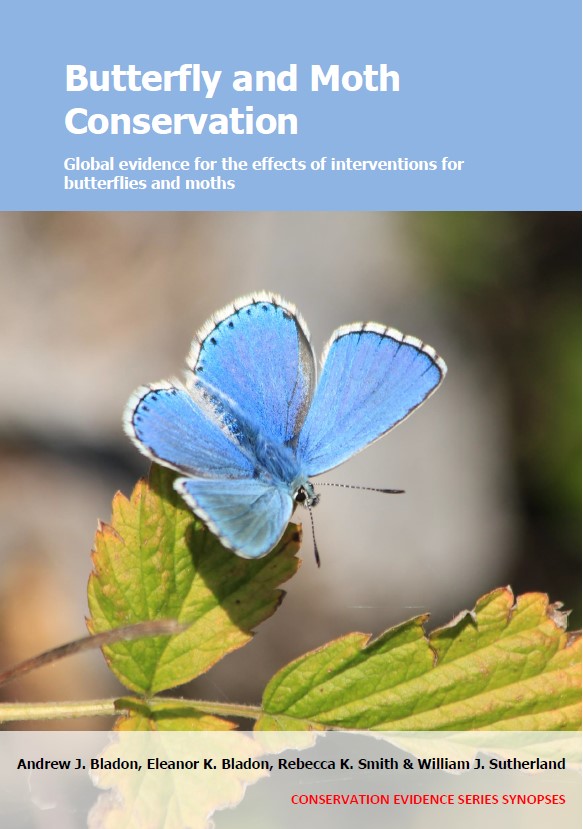Actions to conserve biodiversity
We have summarised evidence from the scientific literature about the effects of actions to conserve wildlife and ecosystems.
Review the evidence from the studies
Not sure what Actions are? Read a brief description.
Search for evidence
e.g. "frogs chytrid"
152 Actions found
Refine
Hide
152 Actions found
Download Actions
| 0 selected |
|
Order results by:
| Action | Effectiveness | Studies | Category | |
|---|---|---|---|---|
|
Manage land under power lines for butterflies and moths Action Link |
Awaiting assessment | 6 |
|
|
|
Manage natural waterbodies in arid areas to prevent desiccation Action Link |
No evidence found (no assessment) | 0 |
|
|
|
Manage perennial bioenergy crops to benefit butterflies and moths Action Link |
Awaiting assessment | 1 |
|
|
|
Manage rice field banks to benefit butterflies and moths Action Link |
Awaiting assessment | 1 |
|
|
|
Manage vineyards to benefit butterflies and moths Action Link |
Awaiting assessment | 2 |
|
|
|
Manage wetlands or ponds by grazing or cutting to prevent succession Action Link |
Awaiting assessment | 3 |
|
|
|
Manage woodland edges for maximum habitat heterogeneity Action Link |
Awaiting assessment | 2 |
|
|
|
Mark the location of webs or caterpillars before mowing Action Link |
Awaiting assessment | 1 |
|
|
|
Mechanically remove mid-storey or ground vegetation to create fire breaks Action Link |
Awaiting assessment | 2 |
|
|
|
Minimize road lighting to reduce insect attraction Action Link |
No evidence found (no assessment) | 0 |
|
|
|
Pay farmers to cover the costs of conservation measures (as in agri-environment schemes or conservation incentives) Action Link |
Evidence not assessed | 32 |
|
|
|
Plant crops in spring rather than autumn Action Link |
No evidence found (no assessment) | 0 |
|
|
|
Plant grass buffer strips/margins around arable or pasture fields Action Link |
No evidence found (no assessment) | 26 |
|
|
|
Plant in-field trees (e.g. copses) Action Link |
No evidence found (no assessment) | 0 |
|
|
|
Plant more than one crop per field (intercropping) Action Link |
Evidence not assessed | 1 |
|
|
|
Plant nectar flower mixture/wildflower strips Action Link |
Evidence not assessed | 23 |
|
|
|
Plant new hedges Action Link |
Awaiting assessment | 7 |
|
|
|
Plant parks, gardens and road verges with appropriate native species Action Link |
Awaiting assessment | 8 |
|
|
|
Plant trees to reduce temperatures in cities Action Link |
No evidence found (no assessment) | 0 |
|
|
|
Plant wild bird seed or cover mixture Action Link |
Awaiting assessment | 7 |
|
|
|
Practise ‘wildlife gardening’ Action Link |
Evidence not assessed | 4 |
|
|
|
Produce coffee in shaded plantations Action Link |
Evidence not assessed | 3 |
|
|
|
Protect and connect habitat along elevational gradients Action Link |
No evidence found (no assessment) | 0 |
|
|
|
Protect greenfield sites or undeveloped land in urban areas Action Link |
Awaiting assessment | 2 |
|
|
|
Protect in-field trees Action Link |
Evidence not assessed | 1 |
|
Download Actions
| 0 selected |
|

Butterfly and Moth Conservation - Published 2023
Butterfly and Moth Synopsis
Watch this search
If you are familiar with RSS feeds, please click the button below to retrieve the feed URL:
RSS feed for this searchIf you are unfamiliar with RSS feeds, we would suggest reading this BBC article.
Unfortunately, due to the number of feeds we have available, we cannot provide e-mail updates. However, you could use tools such as Feed My Inbox to do this for you.
What are 'Individual studies' and 'Actions'?
Individual studies
An individual study is a summary of a specific scientific study, usually taken from a scientific journal, but also from other resources such as reports. It tells you the background context, the action(s) taken and their consequences.
If you want more detail please look at the original reference.
Actions
Each action page focuses on a particular action you could take to benefit wildlife or ecosystems.
It contains brief (150-200 word) descriptions of relevant studies (context, action(s) taken and their consequences) and one or more key messages.
Key messages show the extent and main conclusions of the available evidence. Using links within key messages, you can look at the paragraphs describing each study to get more detail. Each paragraph allows you to assess the quality of the evidence and how relevant it is to your situation.
Where we found no evidence, we have been unable to assess whether or not an intervention is effective or has any harmful impacts.





)_2023.JPG)














